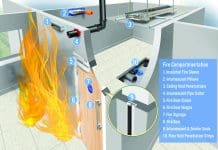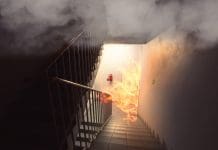Reading and understanding standards and codes of practice is the fire industry professional’s bread and butter – but sometimes there are some issues and pitfalls that it can be easy to fall into
The Fire Industry Association (the UK’s largest trade association for the fire protection sector – and now also, the largest in Europe) has produced recent guidance about BS 7273-4:2015, and its application. This standard can be difficult to follow without some careful consideration – so it’s important to understand all the technical ins and outs.
BS 7273-4 Code of practice for the operation of fire protection measures – part 4: Actuation of release mechanisms for doors was published on 30 June 2015. It replaces the 2007 version, which is superseded, and although the 2015 version is heading towards three years old, it is all too easy to forget which parts were updated. So for those of you who need a refresh, read on…
BS 7273-4: 2015 in a nutshell is about the operation and release of electronically controlled fire doors. It recommends how to actuate mechanisms that unlock, release or open doors in the event of fire in all buildings including dwellings (except where stated).
It provides recommendations for the design, installation, commissioning and maintenance of electrical control arrangements for actuation of mechanisms that unlock, release or open doors in the event of fire. It applies to all aspects of the interface between these mechanisms and a fire detection and fire alarm system, including interfaces that incorporate acoustic coupling and radio transmission.
It also enhances some of the recommendations of BS 5839-1 with regard to detector siting and spacing in certain categories of system. So don’t get caught out here: both standards should be referred to when specifying systems.
Uses for door release mechanisms
Why might electronically controlled doors be used anyway? There are a number of instances where electronic door release mechanisms might be used, and for those that are already in the security world, these may be obvious and apparent since security itself is one of the main reasons it might be considered.
For security reasons, it may be necessary to keep a particular door shut – but it may be impractical to keep it locked with lock and key, since if the door is also being used as a fire exit, people will need to use it to escape. In this case controlled-access doors with an electronic door mechanism may be installed if there is a need to release the door in case of fire, for example if the door leads to staff areas.
The second reason why a door release mechanism may be used is down to accessibility. In some situations, for the sake of accessibility, there may be a need to keep doors in corridors open. However, as we all should be aware, an open door invites fire to spread much more rapidly through the building. Here a door mechanism may be employed to close the doors to prevent the spread of fire.
The final reason for installing a door release mechanism is simple: convenience. In some situations, such as doors to shops, it may make more sense to install automatic doors that will open in the event of fire to ensure safe exit of all staff, customers, and site visitors.
From these three examples, it is easy to see how different doors for different buildings can be used in different ways, and also in some circumstances there are different needs too – and that all depends on whether the door needs to open or shut in the event of fire.
The problems with BS 7273-4
As such, the problem with the application of BS 7273-4 is that it can be a very demanding standard that can be difficult to meet due to the different needs and requirements of different doors throughout the building. Which doors should be released? When? How do you make the fire alarm system communicate with the door release mechanism? How do you get the ‘failsafe’ to work? This can sometimes be made all the more complicated in bigger buildings with multiple storeys and a wide variety of doors.
In addition, different buildings have different needs and each case needs to be treated individually. What might work for one building might not work for another, even if there are many similarities (as we have already discussed above).
There is also a conflict between two standards: what BS 5839-1 says may confuse your interpretation of BS 7273-4. If you’re wondering, by the way, the answer is that BS 7273-4 takes precedence (but only for category L4 or L5 systems). So if the design of the building calls for a category L1, L2, or L3 design, stick with BS 5839-1 and the guidance within. Otherwise for category L4 or L5 systems, design the system with BS 7273-4 in mind.
That said, this article is by no means substitute for reading the standards and obtaining relevant training, but thankfully we are able to break this standard down into three quick tips to get you started, and the FIA will also be publishing a handy technical document on its website shortly that will help summarise it too (sign up to our technical newsletter to receive it in your inbox!).
Advice for working with BS 7273-4
Tip #1: Identify the type of door mechanism.
Is it going to unlock or just open? How will you get the door to fulfil its role as a fire door?
Door release mechanisms are typically one of three things. They could be electromagnetic door holders that release self-closing doors in an emergency; or electromagnetic locks that prevent unauthorised access but will still release in an emergency; or powered sliding doors that open in an emergency. Take these into consideration when thinking about fire doors and their purposes.
Tip #2: Identify the categories of the door systems.
By identifying the category of door system, you can base your design for the alarm system on these factors.
For those of you not ‘in the know’, there are three categories that you need to worry about: critical, standard, and indirect. Where and how you can use these different categories of door system depends a lot on the building and the environment you are working within. In some cases, it may be worth noting that enforcing authorities may not allow electronically secured doors, such as in school buildings where only the critical category of doors may be applied if permitted.
There are further areas of guidance that may need to be considered if the building is a hospital, care home, or HMO, but you can read about this in the FIA’s upcoming technical documents (listed at the end of this article, and due for release very shortly).
Tip #3: If you want to know what type or category of fire door you’re working with, Annex B in the standard is your friend.
Annex B of BS 7273-4 details the different categories of fire door and helps you clarify what you’re working with.
If you haven’t got a copy of BS 7273-4, you can purchase a copy from the British Standards website. Alternatively, if you decide that you’d like your company to become a member of the Fire Industry Association, you can obtain Standards at a specially discounted rate just for members (just one of many handy perks of membership).
In addition, the FIA has published a technical document that will help break down BS 7273-4.
‘FIA Application Guidance on BS 7273-4:2015’ (coming soon) summarises the standard and should work as an aide-memoir. In this document you’ll learn more about door release mechanisms, why and when door release mechanisms could be installed, and in-depth explanations of the three types of door release mechanisms: critical, standard, and indirect. There is also a range of handy reference charts and diagrams to refer to so that you can find out how to space the detectors in relation to the doors.
At the time of writing another technical document on the subject is also being produced. The handy PDF document, ‘Update on BS 7273-4:2015’ does what it says on the tin: you’ll learn all the changes that were made in 2015 (a few years ago now, but it doesn’t hurt to refresh yourself). This includes information about door-closing mechanisms, means of escape, and changes in terminology that you need to get familiar with (if you aren’t already).
As with all our technical documents, they are created by technical experts and FIA members who sit on a range of FIA councils. These groups work to ensure that the information presented is the most accurate and up-to-date information available.
Both guides are coming soon and will be available to download from the Resources library. All technical documents mentioned in this article are free to download.
Sign up to the Technical Newsletter to find out when ‘FIA Application Guidance on BS 7273-4:2015’ and ‘Update on BS 7273-4:2015’ will be published.



![[Video] Enhancing safety with fire doors: A case study of Marina Care Home](https://www.pbctoday.co.uk/news/wp-content/uploads/2025/06/maxresdefault-218x150.jpg)



![[VIDEO] Making DorTrak reports easy to read with Fireco Inspecting fire doors at Fireco, firedoor technology, 2023](https://www.pbctoday.co.uk/news/wp-content/uploads/2024/04/JPZ_2364-web-218x150.jpg)





![[VIDEO]What to expect when you’re inspecting: Using DorTrak for fire door inspections](https://www.pbctoday.co.uk/news/wp-content/uploads/2025/02/maxresdefault-218x150.jpg)